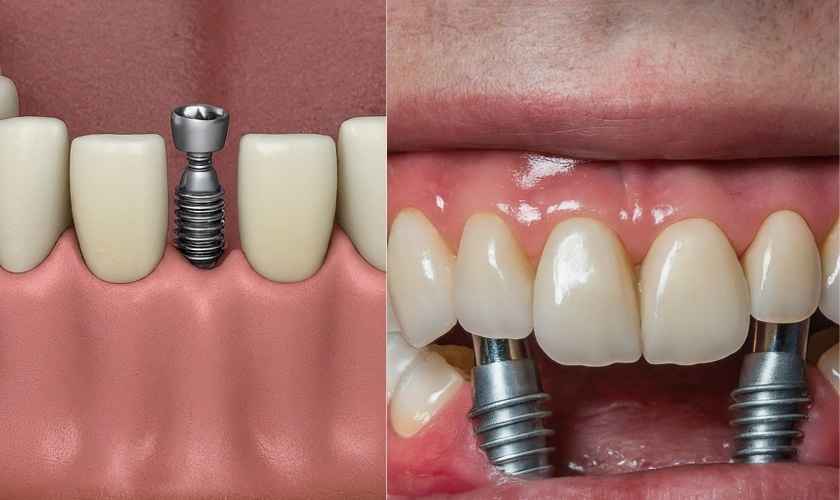The 10-Minute Rule for Dental Sense
Table of ContentsNot known Details About Dental Sense What Does Dental Sense Mean?Some Ideas on Dental Sense You Need To KnowSome Ideas on Dental Sense You Need To Know
are clinical devices surgically implanted right into the jaw to bring back a person's ability to eat or their appearance. They provide support for synthetic (fake) teeth, such as crowns, bridges, or dentures. When a tooth is lost because of injury or condition, an individual can experience complications such as fast bone loss, malfunctioning speech, or modifications to eating patterns that result in discomfort.Oral dental implant systems contain an oral implant body and dental implant joint and may likewise include an abutment addiction screw. Dental veneers cost. The dental implant body is surgically placed in the jawbone instead of the tooth's origin. The dental implant abutment is typically attached to the implant body by the joint addiction screw and expands through gum tissues right into the mouth to sustain the connected artificial teeth
(https://www.find-us-here.com/businesses/Dental-Sense-Miami-Florida-USA/34200016/)Structure of The Oral Implant System choosing oral implants, speak with your dental company regarding the potential advantages and dangers, and whether you are a candidate for the procedure. Points to think about: Your general health is a crucial consider establishing whether you are an excellent candidate for oral implants, how long it will require to heal, and how much time the implant may stay in area.
Smoking might influence the healing procedure and decrease the lasting success of the dental implant. The recovery process for the implant body might take a number of months or longer, throughout which time you usually have a momentary abutment in area of the tooth. the dental implant treatment: Thoroughly comply with the dental health guidelines provided to you by your dental provider.
Indicators on Dental Sense You Need To Know
Implant failing can cause the demand for an additional operation to repair or change the dental implant system. Brings back the ability to chew Restores aesthetic look Helps maintain the jawbone from diminishing because of bone loss Preserves the health and wellness of the bordering bone and periodontals Assists maintain adjacent (close-by) teeth steady Improves lifestyle Damages to surrounding natural teeth during implant placement Injury to the surrounding tissues during surgery, such as sinus perforation Injury during surgical treatment (for instance, fracture of bordering jawbone) Inadequate function, such as seeming like the teeth do not attack together typically An experience that the tooth is loose or turning in location resulting from a joint screw loosening Implant body failure (looseness of the implant body) due to systemic infection, which may be more most likely in patients with unchecked diabetes mellitus as a result of neighborhood infection in bone and gums sustaining the implant body due to delayed recovery, which may be more probable in clients that smoke Problem cleansing the gum tissues around the implant, leading to inadequate dental hygiene Without treatment periodontal disease Post-surgical pins and needles as a result of nerve impingement or damage Constantly alert healthcare suppliers and imaging service technicians that you have dental implants before any kind of magnetic resonance imaging (MRI) or x-ray treatments.
FDA is not conscious of any kind of negative events reported for MRI or x-ray treatments with oral implants. Oral implants systems are usually constructed from materials that follow global agreement standards of the International Company for Standardization (ISO) or ASTM International. These requirements have information of what makes a risk-free material.

A dental implant is a structure that changes a missing out on tooth. With screw-like devices, the doctor inserts an implant right into the jawbone, and it acts as an anchor for an artificial tooth, called a crown.
Getting The Dental Sense To Work
Some people are not eligible for oral implant surgical treatment. It is for oral specialists to operate on people with: intense illnessuncontrollable metabolic diseasebone or soft tissue condition or infectionIf these issues are dealt with, a person can have the surgical procedure. In, oral cosmetic surgeons avoid from operating on people with: If individuals with any one of the above undertake dental implant surgery, there is a higher threat of the dental implant stopping working.

Dental dental implant surgery is a tailored procedure. It's not the very same for every person. Yet the following provides a general summary of what you can expect your dentist, oral doctor, periodontist or prosthodontist to do: Position the implant operatively. Provide you time to heal. Connect the click this blog post and final crown, bridge or denture.
Next, your cosmetic surgeon will thoroughly place the oral implant into your jaw. Lastly, your surgeon will reposition your gums and shut the incision with stitches. If your implant is near the front of your mouth, your dentist will make a short-lived tooth for you to use till you heal. By doing this, you won't have a gap in your smile while you recoup.
The 15-Second Trick For Dental Sense
During the healing phase, your jawbone ought to fuse to the oral implant. This procedure can take anywhere from 3 to 9 months.
Once your dental implant heals, your dental professional can connect the abutment (small adapter blog post) and your last restoration (crown, bridge or denture). This usually takes about one hour to complete and might call for a second minor surgical treatment. You shouldn't really feel any kind of pain during your oral implant procedure because your copyright will certainly make use of drug to numb your gum tissues.